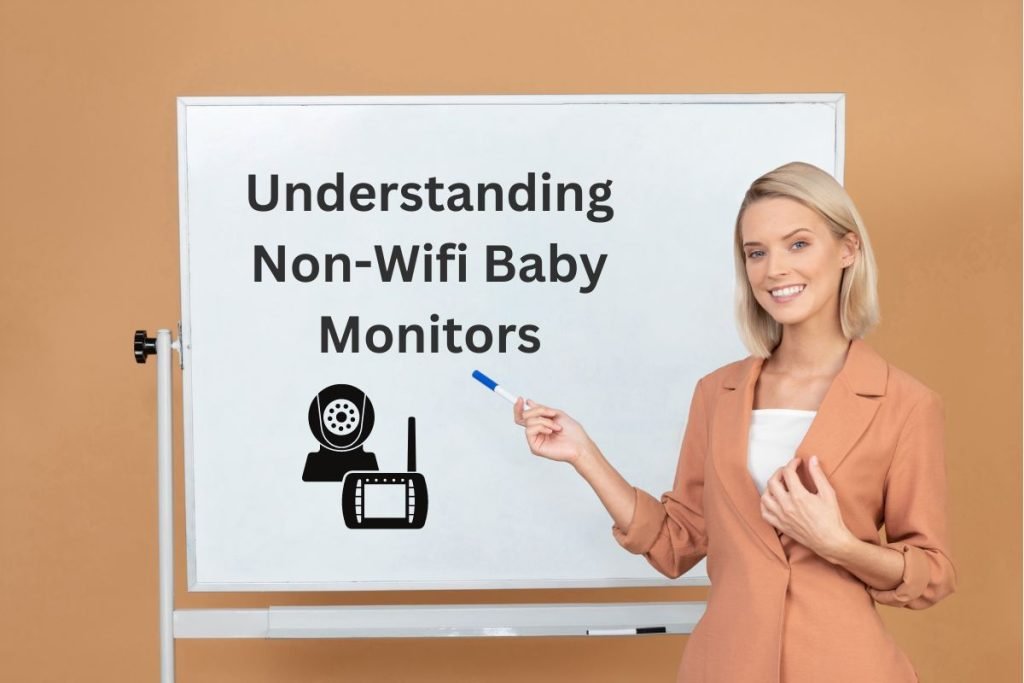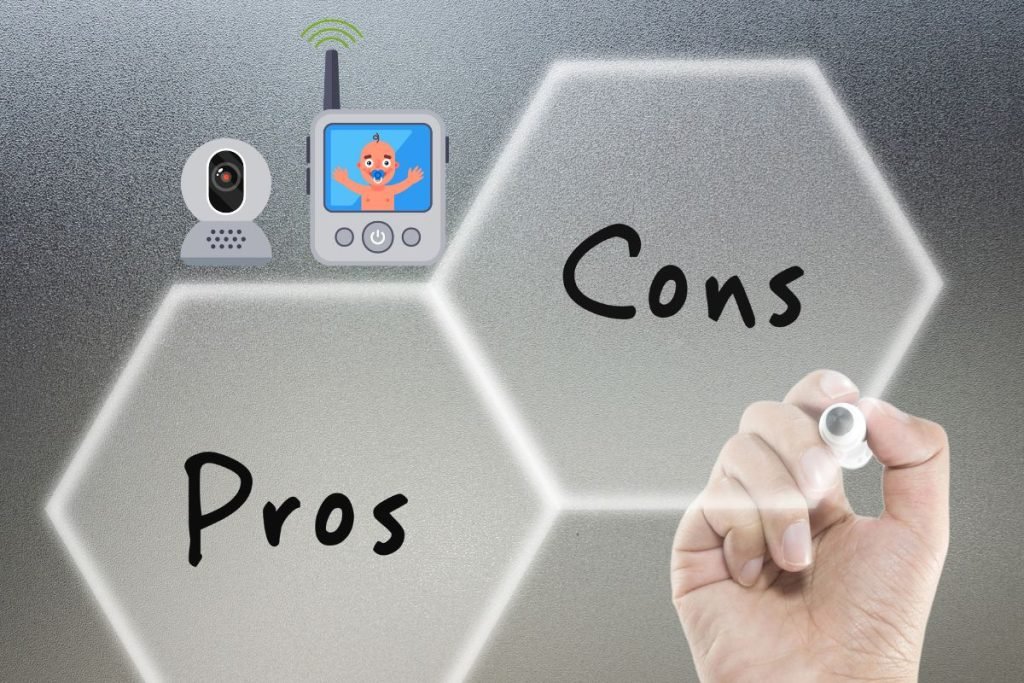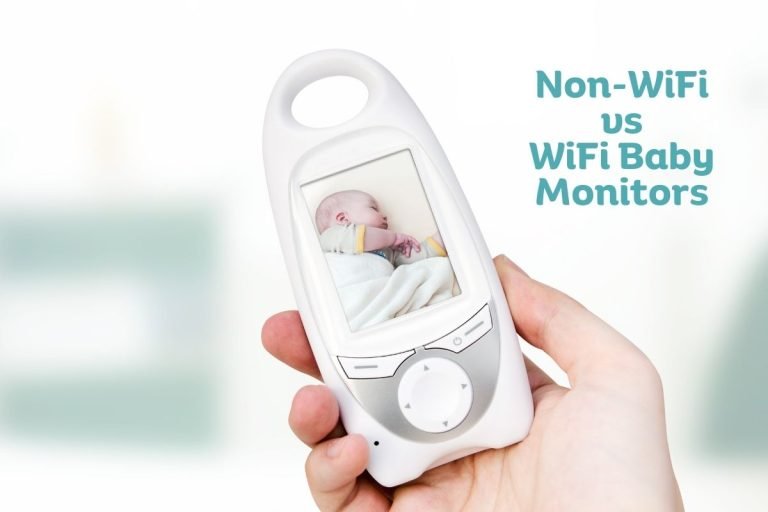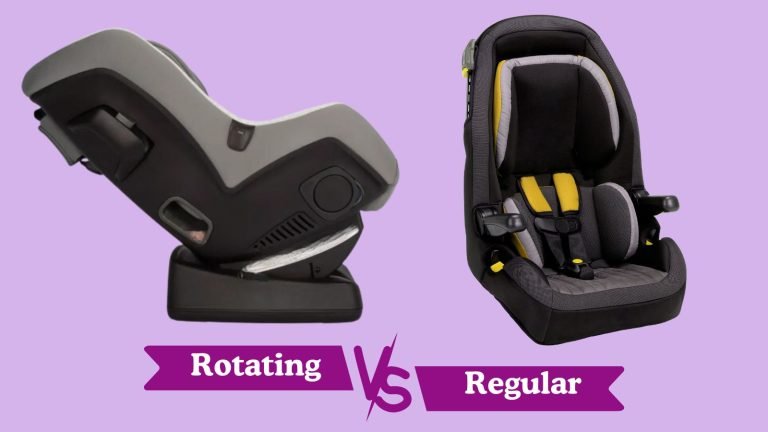How Non-Wifi Baby Monitor Works: Essential of Non-Wifi Monitor in 2025

Imagine a world where your baby’s every whimper, rustle, and breath is monitored without worrying about hacking or signal loss. Welcome to the realm of non-wifi baby monitors.
These little dynamos work using a simple, direct link between the monitor and receiver, eliminating the need for another wireless internet connection. You’ll find out how they work, their key features, and the pros and cons of using one.
The safety concerns you might have will be addressed, too. It’s a choice not just about technology but peace of mind.
So, let’s dive in and explore how a non-wifi baby monitor works and is a perfect fit for the baby unit in your family.
Key Takeaways – How Non-Wifi Baby Monitor Works
- Non-wifi baby monitors use radio frequencies for communication.
- They consist of a transmitter (baby’s unit) and a receiver (parent’s unit).
- Non-wifi monitors have superior battery life and do not require an internet connection.
- They provide enhanced privacy and reduce the risk of hacking compared to wifi monitors.
Understanding Non-Wifi Baby Monitors

Often, you might wonder how a non-wifi baby monitor functions without internet connectivity. Unlike their wifi counterparts, these devices rely heavily on radio frequencies to transmit video. You’ve got a transmitter (baby’s unit) and a receiver (parent’s unit).
The transmitter broadcasts the sounds and background noise made by the traditional baby monitors, and the receiver picks them up within a certain monitor range.
Monitor range is a key factor to consider when selecting a non-wifi monitor. It’s the distance between the receiver and the transmitter where the signal remains clear and undistorted. You’re looking for a range that covers your home’s layout and size.
Battery life also plays a crucial role. Most non-wifi monitors run on batteries, so you’ll replace or recharge them regularly. The battery life can vary depending on the model, usage, and brand. You don’t want to be left in a lurch with a dead monitor in the middle of the night, right?
To explore the differences between WiFi and non-WiFi options, check out our guide on Non-Wifi vs Wifi Baby Monitors.
The Working Mechanism

Diving deeper into the working mechanism, you’ll find that the non-wifi baby monitor’s basic function hinges on radio frequency technology.
These monitors transmit audio and sometimes video signals to a receiver unit over designated frequencies to transmit signals. The whole process is akin to the way walkie-talkies or cordless phones operate.
The operation of a non-wifi baby monitor can be summarized into two main components: Monitor Durability and Signal Strength.
Monitor Durability
The durability of a non-wifi baby monitor is often high. These devices are designed to withstand typical household accidents like drops or spills.
Signal Strength
Signal strength can vary greatly depending on transmission distance, the monitor’s quality, and the distance between the transmitter and receiver units. High-quality monitors will have a strong signal strength, ensuring clear and uninterrupted communication.
Features of Non-Wifi Baby Monitors

Beyond the primary aspects of durability and signal strength, you’ll find several other features in non-wifi baby monitors that make them a top choice for many parents.
Non-wifi baby monitors have been meticulously engineered for optimal performance, prioritizing the best baby monitor for durability and battery longevity, among other features.
Here are some distinct characteristics that make non-wifi baby monitors stand out:
- Monitor Durability: These devices are built to last. They can withstand knocks, drops, and all the general wear and tear of continual usage.
- Battery Longevity: Non-wifi baby monitors often have superior battery life. They’re designed to run for hours, ensuring you don’t run out of power in the middle of the night.
- Interference-Free: Unlike Wi-Fi monitors, non-Wi-Fi monitors are less prone to interference from other devices. This results in clearer audio and video quality.
- Privacy: Since these monitors don’t connect to the internet, there’s no risk of potential hackers spying on your baby.
Each feature contributes to non-wifi baby monitors’ overall reliability and effectiveness. With these insights, let’s transition into the pros and cons assessment to help you make an informed decision.
Pros and Cons Assessment Non-WiFi

Now, let’s assess the pros and cons of non-Wifi baby monitors.
You’ll appreciate the benefits and understand the potential drawbacks, thus making an informed decision.
It’s key to analyze both sides to understand what non-Wifi baby monitors can offer.
Non-Wifi Monitor Benefits
In assessing the benefits of a non-Wifi baby monitor, you’ll discover several key advantages and possible drawbacks that could influence your decision.
One undeniable benefit is battery longevity. Most non-Wifi monitors use less power than their Wifi counterparts, resulting in longer battery life.
This also makes them cost-efficient, saving you from frequent battery replacements or charging.
While non-Wifi monitors have limitations, their benefits might outweigh the drawbacks, depending on your needs. Weigh these factors carefully to make the best choice for your family.
Potential Drawbacks Assessment
While you might appreciate non-Wifi baby monitors’ cost-effectiveness and battery longevity, it’s also essential to consider potential drawbacks.
One challenge could be the limited range. Unlike WiFi monitors, non-Wifi monitors’ signal strength transmission range is confined to a particular radius, which might be inadequate for larger homes.
Furthermore, while the battery life is generally longer, if the monitor is continuously used, it may drain faster than expected, necessitating frequent replacements or recharging.
Additionally, non-Wifi monitors lack advanced features found in their Wifi counterparts, like remote access and data analysis.
Lastly, these monitors may encounter interference from other electronic devices, affecting their performance.
Thus, weighing these constraints against the advantages is crucial before deciding.
f you’re wondering how to set up and effectively use your baby monitor, visit our step-by-step guide on How to Use a Baby Monitor.
Safety Concerns Addressed

You might wonder about the safety issues associated with a non-WiFi baby monitor.
We’ll explore how these devices address hacking risk reduction, radiation exposure mitigation, and interference-free monitoring.
Detailed analysis of these points will provide insight into the safety advantages of choosing a non-WiFi baby monitor.
Hacking Risk Reduction
Choosing a non-Wifi baby monitor significantly lowers your risk of being targeted by hackers, offering a safer option for monitoring your baby.
This is due to cybersecurity enhancements and superior parental control options. Non-Wifi video monitors also provide encrypted communication channels far less susceptible to cyber threats.
Here are some reasons to consider a non-Wifi baby monitor:
- Enhanced Privacy: Your data stays within a closed system, limiting external access.
- Lower Hacking Risk: Without internet connectivity, unauthorized intrusion is less likely.
- Controlled Access: Only devices you pair with the monitor can access its feed.
- No Dependency on the Internet: It operates independently of your home’s internet, reducing vulnerability to Wi-Fi-based attacks.
Radiation Exposure Mitigation
Another significant advantage of non-Wifi baby monitors is their ability to mitigate radiation exposure, offering an even safer option.
The health implications of long-term radiation exposure are widely documented. Therefore, using alternative technologies like FHSS, non-Wifi monitors emit less harmful radiation than Wifi-based monitors.
Here’s a table to illustrate the difference in radiation levels:

Non-Wifi monitors’ lower radiation levels directly translate to fewer potential health risks, especially for babies. Choosing a non-Wifi baby monitor is prudent to reduce radiation exposure and ensure your baby’s safety.
Interference-Free Monitoring
Non-Wifi baby monitors offer you the benefit of interference-free monitoring, significantly addressing safety concerns.
They use radio frequencies, which provide a secure and private connection between the monitor and the parent unit. Unlike Wifi monitors, they’re not susceptible to hacking, adding an extra layer of security.
Key Features Include
- Signal Strength: Non-Wifi monitors have robust signal strength, ensuring clear audio and video transmission.
- Battery Life: Expect longer battery life compared to Wifi units, reducing the need for frequent charging.
- Privacy: Radio frequencies offer a more secure connection, protecting your baby’s privacy.
- Interference-Free: Other wireless devices don’t affect these monitors, resulting in interference-free monitoring.
With these benefits, you’re better equipped to make the right choice for your baby’s safety.
Making the Right Choice

When it comes to your baby’s safety, you’ve got to consider the pros and cons of a non-wifi baby monitor before making a decision.
Parental decision-making involves much more than just picking a product off the shelf. You need to evaluate the device’s interference-free potential, its range, and the clarity of its audio and video.
Product affordability is another crucial factor. High-end non-wifi monitors can offer premium features like temperature sensors and lullaby players. However, remember that these extras often come with a hefty price tag. You’ll need to balance your budget against the advantages those features bring.
Don’t overlook the monitor’s power consumption. A device that drains batteries quickly can cost more in the long run. Also, consider the product’s longevity. A sturdy, well-made monitor will serve you better and longer, providing good value for your money.
Lastly, ease of use is paramount. A monitor with a complex setup or confusing controls can cause unnecessary stress. Choose a user-friendly model that allows you to monitor your baby effectively without a steep learning curve.
Summary
In conclusion, non-Wifi baby monitors offer a reliable, interference-free solution for your baby’s sleep and keeping an eye on your little one. They’re easy to use, secure, and often come with handy features.
However, they also have drawbacks, such as limited range and lack of advanced functionalities.
Ultimately, your choice should balance your baby’s safety, your peace of mind, and your particular needs. So, thoroughly evaluate all aspects before making a decision.
Frequently Asked Questions
What Are Some Popular Brands of Non-Wifi Baby Monitors?
You’ll find popular non-WiFi monitor brands like Infant Optics and Vtech. They’re often chosen for their affordability and screen quality. However, it’s best to compare different models to find the perfect fit for your needs.
How to Troubleshoot Common Issues With Non-Wifi Baby Monitors?
You’ll want first to handle signal interference to troubleshoot common issues with non-wifi baby monitors. Check for nearby devices causing disruption. If that doesn’t work, consider battery replacement. It’s often a simple fix.
Are There Any Additional Accessories Required for Non-Wifi Baby Monitors?
No, you don’t need additional accessories for non-wifi baby monitors. They’re usually complete kits, saving you from accessory costs. The installation process is straightforward: plug in, turn on, and set up.
How Does the Battery Life of a Non-Wifi Baby Monitor Compare to a Wifi-Based One?
Non-wifi baby monitors often outlast wifi ones due to superior power efficiency. You’ll appreciate their diverse charging techniques that extend battery life. However, with most wifi baby monitors, actual battery life may vary based on model and usage.
Can Non-Wifi Baby Monitors Be Used for Twins or Multiple Babies?
Non-wifi baby monitors can be video monitors for twins or multiple babies. They often include twin-specific features like split-screen viewing, allowing you to monitor video baby or both babies’ activities simultaneously without switching screens.





